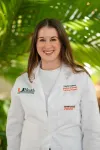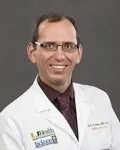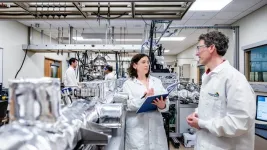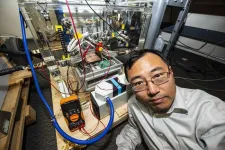(Press-News.org) MIAMI, FLORIDA (STRICTLY EMBARGOED UNTIL SEPT. 29, 2023 AT 5PM ET) – Is it true progression or pseudoprogression in tumor growth?
That’s the critical question for radiation and medical oncologists treating patients with glioblastoma, the most common and aggressive form of brain cancer. Distinguishing between these types of progression is vitally important for treatment management.
“Knowing if it’s true progression, indicative of a poor response to treatment, or pseudoprogression, a favorable response that may look worse due to swelling or tumor necrosis, is essential for clinicians,” said Eric Mellon, MD, PhD, a radiation oncologist and researcher with Sylvester Comprehensive Cancer Center at the University of Miami Miller School of Medicine. “That knowledge can guide us in adjusting current treatment in real time.”
He and his research colleagues are presenting results from two recent studies on this topic at ASTRO 2023, the annual meeting of the American Society for Radiation Oncology, Oct. 1-4, in San Diego.
One study was designed to determine if daily monitoring of tumor changes during a course of radiation therapy could result in early prediction of treatment response. The MRI-guided linear accelerator systems, known as MR-linac, that deliver radiation therapy allow for this type of monitoring and detection of patterns within these volume changes.
Sylvester researchers used sophisticated analytical and machine learning tools, including a linear fitting model to test their prediction theory on a prospective cohort of glioblastoma patients undergoing chemoradiation for their cancers.
“The model was trained to predict between no progression, pseudoprogression and true progression, and the results were cross-validated,” explained Kaylie Cullison, an MD/PhD student who is conducting her PhD research in Mellon’s Sylvester laboratory, is the study’s first author, and will present the data at ASTRO 2023.
Of the 28 patients analyzed in the study, 11 had no tumor growth on first diagnostic MRI after treatment (no progression), five were found to have pseudoprogression based on long-term stability of MRI findings, and 12 had true progression determined by continuing tumor growth beyond six months, tissue sampling showing active malignancy or rapid death.
The model achieved an overall accuracy of 86%, when predicting three outcome classes (no progression, true progression and pseudoprogression), and an accuracy of 93% when predicting between no progression versus any kind of progression.
“We identified patterns of tumor behavior during therapy that were indicative of differences in growth patterns between true progression and pseudoprogression,” said Mellon, co-leader of Sylvester’s Neuro-Oncology Site Disease Group who leads numerous clinical trials for brain tumors. “These volume changes during treatment may be early markers of treatment response.”
Next steps, according to Mellon and Cullison, include automating real-time tumor monitoring by using a deep-learning solution for volume delineation on daily treatment scans.
Their other study, conducted simultaneously with the above one, sought to determine the predictive value of weekly delta-radiomic features extracted from MR-linac systems used for treating glioblastoma patients.
Whereas radiomics focus on quantitative features extracted from medical images to correlate with various biological features and clinical endpoints for cancer diagnosis, prognosis and clinical decisions, delta radiomics extend that analysis by examining feature variation at different time points, usually before and after therapy.
In this case, however, the acquisition time points were during therapy. Sylvester researchers deployed supervised machine learning with a sophisticated classification model to predict true progression or pseudoprogression outcomes. Their model included 41 variables – 39 tumor texture features plus lesion volume and mean lesion intensity – per time point to generate the predictions.
Of the 10 most prognostic features, 90% happened during an early time point, suggesting that prognostic changes in the underlying tumor microenvironment occur within the first 15 treatment sessions (or first half of treatment).
“Our findings support the theory that delta-radiomic features from MR-linac radiotherapy can predict treatment response during therapy, which is earlier than current methods,” concluded Mellon. “And doing so would allow physicians to intensify current treatment for poorly responding patients.”
Mellon and Cullison say future research should include a larger patient cohort and the use of MR-linac systems with multiparametric MRI to further test the model’s prognostic value.
# # #
END
True progression or pseudoprogression in glioblastoma patients?
New research from Sylvester Cancer strives to help radiation oncologists, other clinicians answer critical question
2023-09-29
ELSE PRESS RELEASES FROM THIS DATE:
ASTRO 2023 Session shines spotlight on physician burnout
2023-09-29
MIAMI, FLORIDA (EMBARGOED UNTIL SEPT. 29, 2023, AT 5 PM ET, 2023) – Physician burnout was already a trending topic within the medical community before 2020, when the COVID-19 pandemic brought national attention to the issue.
Typical stressors such as long hours, poor work-life balance, frustrating insurance denials and cumbersome medical documentation were compounded by new challenges from a novel, deadly virus that killed millions worldwide and necessitated a paradigm shift in care delivery.
The side effects were widespread and readily apparent. By late 2021, research by the American Medical Association, Mayo Clinic and Stanford ...
Embargoed Sylvester Comprehensive Cancer Center ASTRO 2023 Tip Sheet
2023-09-29
ALL INFORMATION EMBARGOED UNTIL 5 P.M. ET ON SEPT. 29, 2023
Panel Discussion
Getting it All Done – Strategies for Coping With Professional Burnout
Crystal Seldon Taswell, MD, Sylvester radiation oncologist and researcher, will co-moderate a panel discussion on physician burnout within radiation oncology and medicine. The discussion, titled “Getting It All Done -- Practical Strategies at All Career Stages,” will include background on the extent of the problem, as well as the curriculum gap for residents regarding time management, balancing ...
University of Cincinnati radiation oncology experts present at national conference
2023-09-29
University of Cincinnati Cancer Center researchers will present abstracts at the American Society for Radiation Oncology (ASTRO) Annual Meeting, held Oct. 1-4 in San Diego.
Lattice therapy shows promise for safer, more effective treatment
In standard radiation treatment, entire tumors receive the same dose of radiation. Cancer Center researchers including Andrew Frankart, MD, are testing the application of a different method called lattice therapy, and he will present three posters detailing research into lattice therapy ...
MD Anderson Research Highlights: ASTRO 2023 Special Edition
2023-09-29
SAN DIEGO ― The University of Texas MD Anderson Cancer Center’s Research Highlights showcases the latest breakthroughs in cancer care, research and prevention. These advances are made possible through seamless collaboration between MD Anderson’s world-leading clinicians and scientists, bringing discoveries from the lab to the clinic and back.
This special edition features presentations by MD Anderson researchers at the 2023 American Society for Radiation Oncology (ASTRO) Annual Meeting. Information on all MD Anderson ASTRO Annual Meeting content can be found at MDAnderson.org/ASTRO.
Read ...
University of Virginia team’s research offers hope for pulmonary fibrosis patients
2023-09-29
Using a new recipe for growing blood vessels from living lung tissue in the lab, a University of Virginia School of Engineering and Applied Science research team has developed an analytical tool that could lead to a cure for idiopathic pulmonary fibrosis, or IPF, a lung-destroying disease.
Fibrosis is chronic scarring of tissue and it can strike nearly every system in the body. According to the National Institutes of Health, the government estimates that 45% of deaths in the United States can be attributed to fibrotic disorders. In the lungs, fibrosis restricts breathing, so understanding how scarring occurs, and ultimately how to stop it, ...
Department of Energy funds new center for decarbonization of steelmaking
2023-09-29
Center to develop cost-effective method for decarbonized manufacturing for steelmaking without a blast furnace.
Steel has a major impact on everyone’s lives and our economy. It is crucial to cars, trucks, airplanes, buildings and more. However, there is a significant issue with its production process. Globally, it accounts for a large percentage of greenhouse gas emissions from the industrial sector.
The U.S. Department of Energy (DOE) recently announced $19 million in funding over four years for DOE’s Argonne National Laboratory ...
New criteria to assess progression in glioma aims to speed discovery of new medicines
2023-09-29
Study Title: RANO 2.0: Update to the Response Assessment in Neuro-Oncology Criteria for High- and Low-Grade Gliomas in Adults
Publication: Journal of Clinical Oncology
Dana-Farber Cancer Institute author: Patrick Y. Wen, MD
Summary: In order to accurately assess the efficacy of novel therapies for brain tumors it is necessary to have reliable criteria to determine response or progression. Response assessment in brain tumors is difficult because of the irregular shapes of the tumors and the fact that many therapies used to treat these tumors can also produce imaging changes that resemble tumor ...
NPS team makes key breakthrough on path to electric aircraft propulsion
2023-09-29
As an institution renowned for innovation efforts grounded in education and research, the Naval Postgraduate School (NPS) has often been called upon to tackle some of the most difficult technological challenges facing the Navy and the nation.
Such a challenge emerged in 2020, when NASA charged NPS and two other research teams with solving a critical barrier facing the development of electric aircraft propulsion (EAP): the creation of a circuit breaker that could support large electric platforms running on direct current (DC) electricity. Thanks to the efforts of a diverse team of faculty and students, as well as several Navy and academic research partners, NPS delivered ...
Berkeley Lab awarded two new centers to counter climate change
2023-09-29
The Department of Energy’s Lawrence Berkeley National Laboratory (Berkeley Lab) will host two new centers dedicated to advancing clean energy technology and combating climate change. The awards are part of DOE’s Energy Earthshots Initiative that launched in 2021 with the goal of speeding up technological breakthroughs and lowering costs.
DOE has so far launched seven Earthshots spanning clean energy and carbon reduction technologies. The Berkeley Lab programs announced today will address two of them: the Hydrogen ...
Stanford researchers unveil new material infused with gold in an exotic chemical state
2023-09-29
For the first time, Stanford researchers have found a way to create and stabilize an extremely rare form of gold that has lost two negatively charged electrons, denoted Au2+. The material stabilizing this elusive version of the valued element is a halide perovskite—a class of crystalline materials that holds great promise for various applications including more-efficient solar cells, light sources, and electronics components.
Surprisingly, the Au2+ perovskite is also quick and simple to make using off-the-shelf ingredients at room temperature.
"It was a real surprise that we were able to synthesize a stable material containing Au2+—I didn't even believe it at ...
LAST 30 PRESS RELEASES:
Injectable breast ‘implant’ offers alternative to traditional surgeries
Neuroscientists devise formulas to measure multilingualism
New prostate cancer trial seeks to reduce toxicity without sacrificing efficacy
Geometry shapes life
A CRISPR screen reveals many previously unrecognized genes required for brain development and a new neurodevelopmental disorder
Hot flush treatment has anti-breast cancer activity, study finds
Securing AI systems against growing cybersecurity threats
Longest observation of an active solar region
Why nail-biting, procrastination and other self-sabotaging behaviors are rooted in survival instincts
Regional variations in mechanical properties of porcine leptomeninges
Artificial empathy in therapy and healthcare: advancements in interpersonal interaction technologies
Why some brains switch gears more efficiently than others
UVA’s Jundong Li wins ICDM’S 2025 Tao Li Award for data mining, machine learning
UVA’s low-power, high-performance computer power player Mircea Stan earns National Academy of Inventors fellowship
Not playing by the rules: USU researcher explores filamentous algae dynamics in rivers
Do our body clocks influence our risk of dementia?
Anthropologists offer new evidence of bipedalism in long-debated fossil discovery
Safer receipt paper from wood
Dosage-sensitive genes suggest no whole-genome duplications in ancestral angiosperm
First ancient human herpesvirus genomes document their deep history with humans
Why Some Bacteria Survive Antibiotics and How to Stop Them - New study reveals that bacteria can survive antibiotic treatment through two fundamentally different “shutdown modes”
UCLA study links scar healing to dangerous placenta condition
CHANGE-seq-BE finds off-target changes in the genome from base editors
The Journal of Nuclear Medicine Ahead-of-Print Tip Sheet: January 2, 2026
Delayed or absent first dose of measles, mumps, and rubella vaccination
Trends in US preterm birth rates by household income and race and ethnicity
Study identifies potential biomarker linked to progression and brain inflammation in multiple sclerosis
Many mothers in Norway do not show up for postnatal check-ups
Researchers want to find out why quick clay is so unstable
Superradiant spins show teamwork at the quantum scale
[Press-News.org] True progression or pseudoprogression in glioblastoma patients?New research from Sylvester Cancer strives to help radiation oncologists, other clinicians answer critical question







